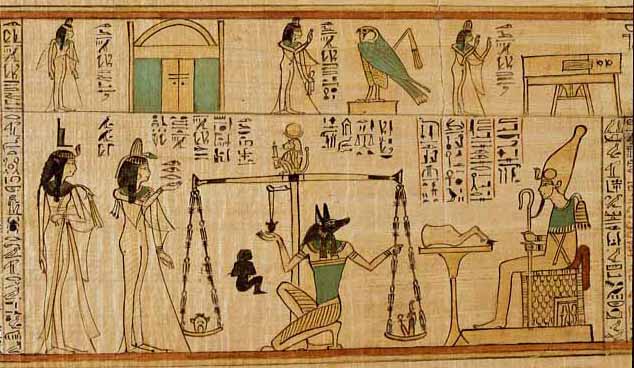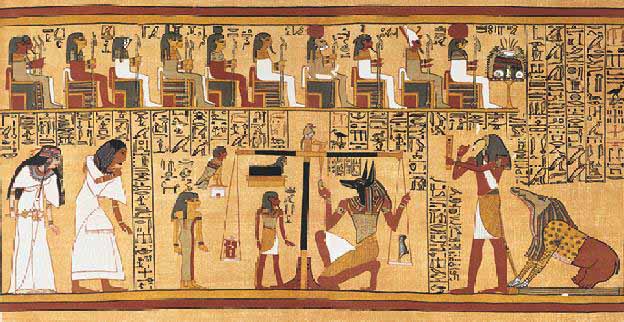The Book of the Dead
Book of the Dead is the common name for ancient Egyptian funerary texts known as The Book of Coming or Going Forth By Day. The name “Book of the Dead” was the invention of the German Egyptologist Karl Richard Lepsius, who published a selection of some texts in 1842.
The Books were text initially carved on the exterior of the deceased person’s sarcophagus, but was later written on papyrus now known as scrolls and buried inside the sarcophagus with the deceased, presumably so that it would be both portable and close at hand. Other texts often accompanied the primary texts including the hypocephalus (meaning ‘under the head’) which was a primer version of the full text.
Books of the Dead constituted as a collection of spells, charms, passwords, numbers and magical formulas for the use of the deceased in the afterlife. This described many of the basic tenets of Egyptian mythology.
They were intended to guide the dead through the various trials that they would encounter before reaching the underworld. Knowledge of the appropriate spells was considered essential to achieving happiness after death. Spells or enchantments vary in distinctive ways between the texts of differing “mummies” or sarcophagi, depending on the prominence and other class factors of the deceased.
Books of the Dead were usually illustrated with pictures showing the tests to which the deceased would be subjected. The most important was the weighing of the heart of the dead person against Ma’at, or Truth (carried out by Anubis). The heart of the dead was weighed against a feather, and if the heart was not weighed down with sin (if it was lighter than the feather) he was allowed to go on. The god Thoth would record the results and the monster Ammit would wait nearby to eat the heart should it prove unworthy.
The earliest known versions date from the 16th century BC during the 18th Dynasty (ca. 1580 BC1350 BC). It partly incorporated two previous collections of Egyptian religious literature, known as the Coffin Texts (ca. 2000 BC) and the Pyramid Texts (ca. 2600 BC-2300 BC), both of which were eventually superseded by the Book of the Dead.
The text was often individualized for the deceased person – so no two copies contain the same text – however, “book” versions are generally categorized into four main divisions – the Heliopolitan version, which was edited by the priests of the college of Annu (used from the 5th to the 11th dynasty and on walls of tombs until about 200); the Theban version, which contained hieroglyphics only (20th to the 28th dynasty); a hieroglyphic and hieratic character version, closely related to the Theban version, which had no fixed order of chapters (used mainly in the 20th dynasty); and the Saite version which has strict order (used after the 26th dynasty).
It is notable, that the Book of the Dead for Scribe Ani, the Papyrus of Ani, was originally 78 Ft, and was separated into 37 sheets at appropriate chapter and topical divisions.
Papyrus of Ani
This is a beautiful color version of the Papyrus of Ani, one of the books of the dead which were often buried with the dead person who could afford to have one written, to ease his/her way into eternal life. Above is a picture from the book. Ani (man with his wife bowing to the gods), while Anubis weighs his heart against Maat’s feather of truth, and Thoth records the event, and Ammit the devourer waits patiently. There are several books by E. W. Budge about this papyrus. But Faulkner’s version is better and more beautiful. And, considering the page after page of beautiful color pictures, this paperback version is amazingly inexpensive. You may find yourself just sitting and marveling at it for hours and hours, maybe years and years.

Archaeologists found this papyrus in the burial of Nany (NAH-nee), a woman in her seventies. She was a chantress (ritual singer) of the god Amun-Re and is referred to as “king’s daughter” (probably meaning she was daughter of the high priest of Amun and titular king, Pinodjem I). As was customary during the Third Intermediate Period, her coffin and boxes of shawabtis (figures of substitute workers for the afterlife) were accompanied by a hollow wooden Osiris figure, which contained a papyrus scroll inscribed with a collection of texts that Egyptologists call the Book of the Dead. The ancient name was the Book of Coming Forth by Day. It is more than seventeen feet long when unrolled. The hieroglyphic inscriptions were written by a scribe, and the illustrations were drawn and painted by an artist.
The scene depicted here shows the climax of the journey to the afterlife. Nany is in the Hall of Judgment. Holding her mouth and eyes in her hand, she stands to the left of a large scale. Her heart is being weighed against Maat, the goddess of justice and truth, who is represented as a tiny figure wearing her symbol, a single large feather, in her headband. On the right, Osiris, god of the underworld and rebirth, presides over the scene. He is identified by his tall crown with a knob at the top, by his long curving beard, his crook, and by his body, which appears to be wrapped like a mummy except for his hands.
At his back hangs a menat as counterweight for his collar. In front of him is an offering of a joint of beef. Jackal-headed Anubis, overseer of mummification, adjusts the scales, while a baboon–symbolizing Thoth, the god of wisdom and writing – sits on the balance beam and prepares to write down the result. Behind Nany stands the goddess Isis, both wife and sister of Osiris. She is identified by the hieroglyph above her head. Nany has been questioned by the tribunal of forty-two gods about her behavior in life. She has had to answer negatively to every question asked in this examination, often called the negative confession.
In this scene Nany has been found truthful and therefore worthy of entering the afterlife. Her heart is not heavier than the image of the goddess of Truth. Anubis says to Osiris, “Her heart is an accurate witness,” and Osiris replies, “Give her her eyes and her mouth, since her heart is an accurate witness.”In the horizontal register above the judgment scene, Nany appears in three episodes: worshiping the divine palette with which all is written, praising a statue of Horus, and standing by her own tomb. Nany had a second papyrus roll with texts entitled What Is in the Underworld (Amduat) wrapped into her mummy in the area across her knees.
The Book of the Dead, the ceremonies, rituals and magic were all done in the hopes that one could reach the Land of the West and a happy afterlife, filled with good things. To live forever with the gods. To, once more, come forth by day as a living man would awaken with the sun.



